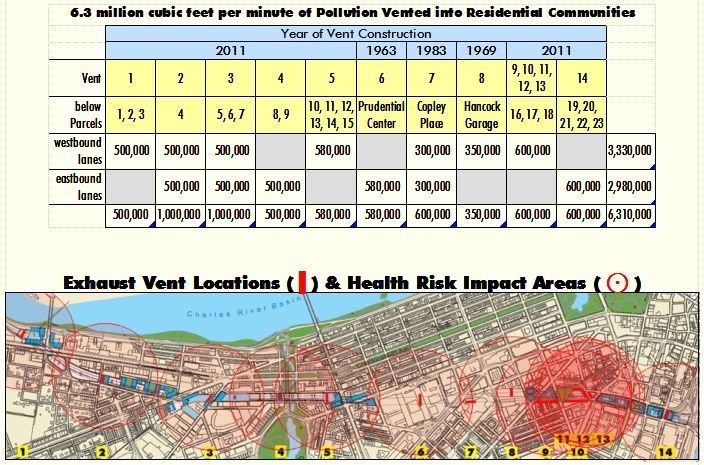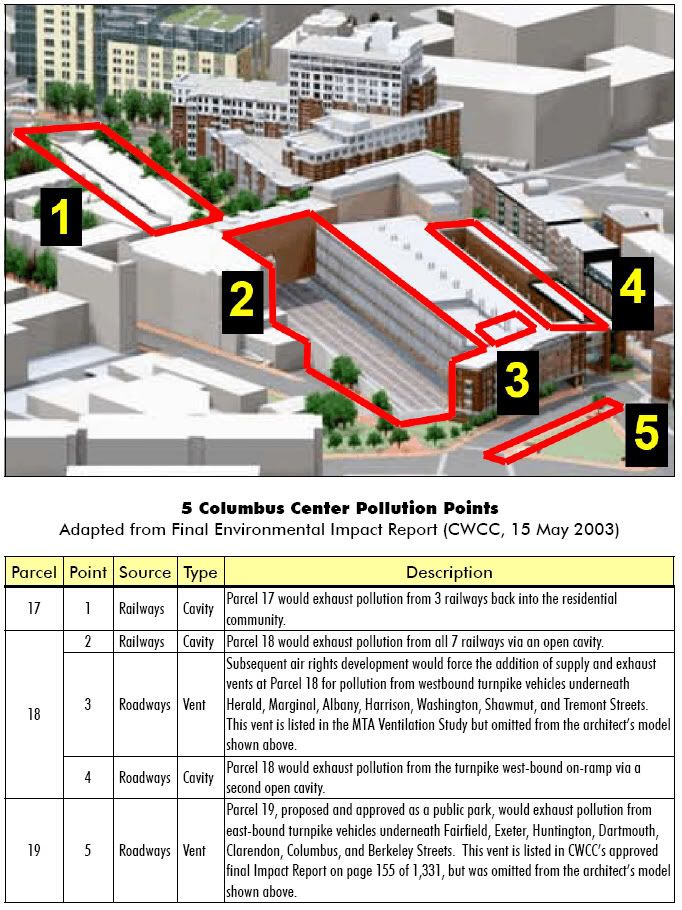Re: Columbus Center
Hello, kmp1284. As requested, here?s UFP air pollution information, updated from the messages posted in summer 2007.
Q-63. What is UFP air pollution?
A-63. The most toxic form of air pollution known is the UFP (ultrafine particulate mattter) emitted by diesel railway engines and gasoline and diesel motor vehicle engines.
First discovered in 1970, and widely recognized since 1990, scientists and public health officials have identified UFP as the worst urban environmental health problem in the modern world, greatly increasing rates of illness and death in roughly 1,640 feet around gasoline and diesel engine transportation corridors such as Boston?s I-93 and I-90.
For people who work or live within that toxic zone, opening doors or windows for ?fresh air? is never safe. But keeping them shut still lets about 50% of UFP air pollution in, because at one thousandth the width of a human hair, UFP easily passes through or around even the best doors, windows, walls, and ceilings. Commercial and residential buildings with fresh-air intake systems cause higher UFP exposure to their occupants than older, smaller buildings without such systems.
Heavy exercise ? indoors or out ? is dangerous inside a UFP toxic zone because aerobic activity greatly speeds the inhalation and absorption of UFP matter through the lungs, into the bloodstream, and throughout the body.
The National Library of Medicine has thousands of scientific studies on particulate matter, and many on UFP, most added since 1996 (when Columbus Center was first proposed).
Mitigating technology that reduces UFP exposure was identified during Boston?s Big Dig project begun in 1984, and during New York?s World Trade Center demolition work begun in 2001.
Q-64. What are the health risks of UFP air pollution?
A-64. Ultrafine air pollution affects males and females, and all ages, including the not yet born, although different demographic groups are affected in slightly different ways.
Especially at risk are: children, older people, and anyone who is physically active within a few blocks of the transportation corridor (fine particles penetrate deeper into the most vulnerable parts of the lungs during exercise).
Short-term exposure is linked to premature death in conjunction with heart and lung disease, non-fatal heart attacks, heart rate changes, irregular heartbeat, and other illness.
Long-term exposure is linked to premature death in conjunction with lung cancer, reduced lung function, chronic childhood respiratory disease, and other illness.
Proven Health Risks of UFP Air Pollution
? 20% increase in all causes of mortality
? 50% increase in death from heart attack and lung cancer
? 44% more lung cancer deaths
? up to 50% more chronic obstructive pulmonary disease among adult women
? chronic lung problems in children 10-18 years old
? up to 100% more childhood asthma, and more frequent exacerbation
? up to 100% more early cancers for children living their first 5 years near highways
? up to 400% more teens who never reach 80% of adult lung capacity
? very high association between UFPs and cardiovascular disease
? 36% increase in low birth-weights
? 27% increase in premature births
? 300% increase in infant cardiac birth defects
? more doctor visits, emergency room care, and hospital admissions
Because of the severe harm to public health, the California Air Resources Board, a recognized authority on such air pollution, advises that no homes, parks, or day care centers should ever be inside the toxic zones of transportation corridors such as Boston?s I-90 and I-93. California?s Columbus Center hosts 5 such toxic zones. People working and living there would suffer the most exposure of all.
KEY SCIENTIFIC STUDIES
An association between air pollution and mortality in six U.S. cities.
Dockery DW, Pope CA 3rd, Xu X, Spengler JD, Ware JH, Fay ME, Ferris BG Jr, Speizer FE. N Engl J Med. 1993 Dec. 9;329(24):1753-9. Environmental Epidemiology Program, Harvard School of Public Health, Boston, MA 02115.
?????Results suggest that fine-particulate air pollution, or a more complex pollution mixture associated with fine particulate matter, contributes to excess mortality in certain U.S. cities.
Particulate air pollution as a predictor of mortality in a prospective study of U.S. adults.
Pope CA 3rd, Thun MJ, Namboodiri MM, Dockery DW, Evans JS, Speizer FE, Heath CW Jr. Am J Respir Crit Care Med. 1995 Mar;151(3 Pt 1):669-74. Department of Environmental Health, Harvard School of Public Health, Boston, Mass.
?????Particulate air pollution was associated with cardiopulmonary and lung cancer mortality. Increased mortality is associated with sulfate and fine particulate air pollution at levels commonly found in U.S. cities.
Reanalysis of the Harvard Six Cities Study and the American Cancer Society Study of Particulate Air Pollution and Mortality.
Daniel Krewski, Richard T Burnett, Mark S Goldberg, Kristin Hoover, Jack Siemiatycki, Michael Jerrett, Michal Abrahamowicz, and Warren H White. Health Effects Institute 2000. Cambridge, Massachusetts.
?????Concluded that the two seminal studies were accurate in all substantive respects.
Lung cancer, cardiopulmonary mortality, and long-term exposure to fine particulate air pollution.
Pope CA 3rd, Burnett RT, Thun MJ, Calle EE, Krewski D, Ito K, Thurston GD. JAMA. 2002 Mar 6;287(9):1132-41. Department of Economics, Brigham Young University, 142 FOB, Provo, UT 84602, USA.
cap3@email.byu.edu.
?????Long-term exposure to combustion-related fine particulate air pollution is an important environmental risk factor for cardiopulmonary and lung cancer mortality.
Spatial analysis of air pollution and mortality in Los Angeles.
Jerrett M, Burnett RT, Ma R, Pope CA 3rd, Krewski D, Newbold KB, Thurston G, Shi Y, Finkelstein N, Calle EE, Thun MJ. Epidemiology. 2005 Nov;16(6):727-36. Department of Preventive Medicine, Keck School of Medicine, University of Southern California, Los Angeles, California 90089-9011, USA.
jerrett@usc.edu
?????Lung cancer death rates increase 44% in zip codes where the population is concentrated within 500 meters of highway intersections.
Association between mortality and indicators of traffic-related air pollution in the Netherlands: a cohort study.
Hoek G, Brunekreef B, Goldbohm S, Fischer P, van den Brandt PA. Lancet. 2002 Oct 19;360(9341):1203-9.
?????Long-term exposure to traffic-related air pollution may shorten life expectancy.
The effect of air pollution on lung development from 10 to 18 years of age.
Gauderman WJ, Avol E, Gilliland F, Vora H, Thomas D, Berhane K, McConnell R, Kuenzli N, Lurmann F, Rappaport E, Margolis H, Bates D, Peters J. N Engl J Med. 2004 Sep 9;351(11):1057-67. Department of Preventive Medicine, University of Southern California, Los Angeles 90089, USA.
jimg@usc.edu Erratum in: N Engl J Med. 2005 Mar 24;352(12):1276.
?????Current levels of air pollution have chronic, adverse effects on lung development in children aged 10-18 years, leading to clinically significant breathing deficits as children reach adulthood.
Air Quality and Automobile Emission Control, 4 Volumes
A Report by the Coordinating Committee on Air Quality Studies, Prepared for the Committee on Public Works, United States Senate, US Government Printing Office 1974.
?????Primary emissions are more damaging to local health than secondary emissions are to regional health.
Q-65. Was UFP air pollution disclosed by Columbus Center?
A-65. No.
The 2003 Columbus Center proposal was obligated to incorporate the mitigating technology identified for Boston?s Big Dig in 1984 and for New York?s World Trade Center demolition in 2001. Despite the obligation to itemize the harmful health impacts of UFP, the developers omitted all mention of it from all proposals, including:
■ Environmental Notification Form #1 (54 pages, 15 March 2001)
■ Environmental Notification Form #2 (72 pages, 30 November 2001)
■ Scoping Determination (501 pages, 5 April 2002)
■ Draft Environmental Impact Report (2,740 pages, 21 November 2002)
■ Final Environmental Impact Report (1,331 pages, 15 May 2003)
Because the owners never disclosed the existence of UFP or the ten-fold increase caused by the project ? captured in the corridor, concentrated in the tunnels, and exhausted via vents ? UFP was never recognized, measured, or addressed during any of the governmental reviews over the last 13 years.
Q-66. How does Columbus Center exacerbate the problem ten-fold?
A-66. The Massachusetts Turnpike Authority?s tunnel ventilation plan, approved in 2003, calls for a 3-mile tunnel enclosing Interstate 90. That tunnel, when combined with the proposed Columbus Center, will build at least 14 air pollution exhaust vents in residential neighborhoods across the city.
These vents will capture, concentrate, and exhaust tunnel-based air pollution from 7 railway lanes and 8 roadway lanes. With fans installed every few blocks across the 3-mile corridor, each vent will exhaust pollution in amounts about ten times greater than what rises evenly out of the entire open-air canyon today.
Cubic feet/minute above are from Conceptual Ventilation Study for the Civic Vision for Turnpike Air Rights in Boston, written by Sverdup/Parsons Brinckerhoff under contract to MTA, 19 March 2003. Vent location and impact area map above is adapted from Turnpike Master Plan (MTA, 28 June 2000) and Final Environmental Impact Report (Columbus Center company, 15 May 2003).
Public subsidy applications filed by the City of Boston and California?s Columbus Center certified that the proposal would enclose all the air pollution in airtight tunnels and improve air quality in nearby streets, neighborhoods, and surrounding areas. But the approved plans do nothing to manage UFP. Instead, they dramatically increase its exposure rates.
No airtight seals were proposed, reviewed, approved, or imposed. The approved plans don?t improve air quality, or enclose the rail lanes, because air pollution from the 7 rail ways and 8 road ways would be captured, concentrated, and exhausted through 14 exhaust vents, affecting thousands of employees and residents in a toxic, 1,640-foot diameter around each vent. Of the 14 vents across I-90, five are at Columbus Center.


